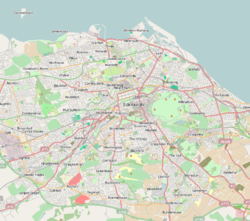History
The drill hall was designed as the headquarters of the 4th Volunteer Battalion of the Royal Scots [1] by connecting several 19th century houses and adding a hall behind them in around 1907. [2] This unit became the 6th Battalion, Royal Scots, in 1908. [2] The battalion was mobilised at the drill hall in August 1914 before being deployed to Alexandria and then to the Western Front. [3] The 5th and 6th battalions, both heavily depleted, were amalgamated in July 1916, and spent the remainder of war on the Western Front as the 5/6th. After the war, the 6th Battalion remained in Belgium until January 1919 when it moved into Germany, and was reduced to a cadre in October 1919 and sent home to be disbanded. [4] After the war the battalion formed a battery in the 57th (Lowland) Medium Brigade, Royal Garrison Artillery based elsewhere in the city. The drill hall instead became the headquarters of 2 (Scottish) General Hospital and of 155 (Lowland) Field Ambulance. [5] These units evolved to become 50 (Scottish) Casualty Clearing Station in 1967 and that unit amalgamated with other units to form 205 (Scottish) General Hospital in 1967. [6]
After the Edinburgh detachment of 205 (Scottish) General Hospital moved out to the Granton Square drill hall in the late 1990s, [7] the Gilmore Place drill hall was decommissioned and, although the hall itself was demolished, the houses that formed the frontage of the property were returned to residential use. [2]
This page is based on this
Wikipedia article Text is available under the
CC BY-SA 4.0 license; additional terms may apply.
Images, videos and audio are available under their respective licenses.

